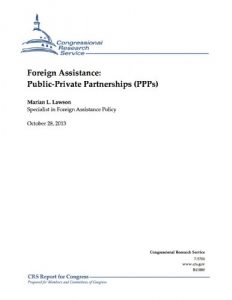The flow of private sector resources to developing countries has increased significantly in recent decades. Seeking opportunity in this changing environment, government development assistance agencies such as the U.S. Agency for International Development and the State Department are working with private sector entities in unprecedented ways to determine when and if such partnerships can lead to improved development results. As explained in the Obama Administration’s 2010 Quadrennial Diplomacy and Development Review (QDDR), “private sector partners can add value to our missions through their resources, their capacity to establish presence in places we cannot, through the technologies, networks, and contacts they can tap, and through their specialized expertise or knowledge.”
Modern public-private partnerships (PPPs), characterized by joint planning, joint contributions, and shared risk, are viewed by many development experts as an opportunity to leverage resources, mobilize industry expertise and networks, and bring fresh ideas to development projects. Partnering with the private sector is also widely believed to increase the likelihood that programs will continue after government aid has ended. From the private sector perspective, partnering with a government agency can bring development expertise and resources, access to government officials, credibility, and scale.
Now a decade after the formation of USAID’s Global Development Alliance (GDA), PPPs for development have received mixed reviews. PPPs require significant effort to create and manage, and critics argue that inadequate data exist to demonstrate that these efforts are the most effective way to use limited development resources. Others have expressed concern about partnerships diverting resources away from proven development programs or recipients. Still others are concerned that PPPs, particularly those involving corporate partners and focusing on trade and economic growth, may lead to outsourcing of U.S. jobs. Partnership proponents have varying views as well. Some feel that the goal of mainstreaming the PPP model as a tool for development has been achieved, while others contend that the potential for using PPPs in development has only begun to be realized and that expanded partnerships are the future of development assistance.
To date, the movement toward this modern concept of development partnership has been driven by successive administrations with limited congressional involvement. However, recent reviews of U.S. foreign assistance policy, together with increasing fiscal constraints, may spur congressional action on foreign assistance reauthorization or reform in the 113th Congress. As part of this effort, Congress may consider several issues that affect or are affected by the use of PPPs, including budget and procurement policies, interagency leadership, international commitments, and the role of aid within broader development policy. This report discusses the evolution of private sector involvement in U.S. foreign assistance programs over recent decades, how globalization has driven the modern approach to development partnerships, potential benefits and drawbacks of PPPs, and how partnerships are being used by other bilateral donors and multilateral development agencies. The report then discusses partnership-related issues that may be of interest to Congress as part of the foreign assistance authorization and reform process.
Modern public-private partnerships (PPPs), characterized by joint planning, joint contributions, and shared risk, are viewed by many development experts as an opportunity to leverage resources, mobilize industry expertise and networks, and bring fresh ideas to development projects. Partnering with the private sector is also widely believed to increase the likelihood that programs will continue after government aid has ended. From the private sector perspective, partnering with a government agency can bring development expertise and resources, access to government officials, credibility, and scale.
Now a decade after the formation of USAID’s Global Development Alliance (GDA), PPPs for development have received mixed reviews. PPPs require significant effort to create and manage, and critics argue that inadequate data exist to demonstrate that these efforts are the most effective way to use limited development resources. Others have expressed concern about partnerships diverting resources away from proven development programs or recipients. Still others are concerned that PPPs, particularly those involving corporate partners and focusing on trade and economic growth, may lead to outsourcing of U.S. jobs. Partnership proponents have varying views as well. Some feel that the goal of mainstreaming the PPP model as a tool for development has been achieved, while others contend that the potential for using PPPs in development has only begun to be realized and that expanded partnerships are the future of development assistance.
To date, the movement toward this modern concept of development partnership has been driven by successive administrations with limited congressional involvement. However, recent reviews of U.S. foreign assistance policy, together with increasing fiscal constraints, may spur congressional action on foreign assistance reauthorization or reform in the 113th Congress. As part of this effort, Congress may consider several issues that affect or are affected by the use of PPPs, including budget and procurement policies, interagency leadership, international commitments, and the role of aid within broader development policy. This report discusses the evolution of private sector involvement in U.S. foreign assistance programs over recent decades, how globalization has driven the modern approach to development partnerships, potential benefits and drawbacks of PPPs, and how partnerships are being used by other bilateral donors and multilateral development agencies. The report then discusses partnership-related issues that may be of interest to Congress as part of the foreign assistance authorization and reform process.












